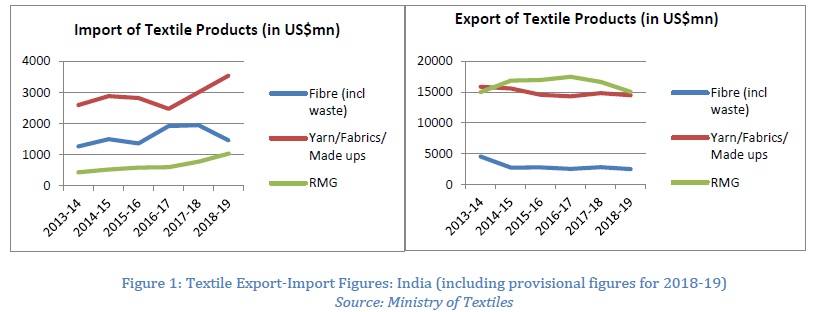
Dear Reader,
The 11th edition of the spotlight looks at the textiles and apparel (T&A) sector in India amidst the national lockdown necessitated by the global pandemic caused due to the SARS-Cov-2 virus.
Hanging by a Thread
What lies ahead for Indian Textiles & Clothing Industry post-COVID-19?
TEXTILES & CLOTHING INDUSTRY IN INDIA: AN OVERVIEW
The key statistics of the T&A industry in India are as follows:[i]
- Share in the Economy – Two percent of India’s gross domestic product (GDP) and seven percent of India’s industrial output in value terms
- Employment – Direct (4.5 crores) and Indirect (6 crores)
- Global Rankings – 2nd largest manufacturer and exporter of T&A, after China and five percent of global T&A trade
PRE-COVID SCENARIO: THE RECENT PAST
Even before COVID-19 struck, the T&A sector in India was facing the heat of an economic slowdown. After the Multi-fibre Agreement of 2005 and the subsequent abolishment of the export quota regime, there was an enhanced focus on capturing overseas markets via exports. Relevant policy measures were introduced, such as TUFS,[i] SITP,[ii] RoSL,[iii] and MEIS.[iv] Furthermore, the recent abolition of the anti-dumping duty on PTA[v] which is a raw material imported for the production of synthetic fibre was a positive move for the sector.
However, the following figure highlights that there is a general reduction in the value of textile-related exports from India and a general increment for textile-related imports to India. However, when reading along with the provisional figures for 2018-19, the trend becomes more severe highlighting the challenges in domestic manufacturing and an increase in dependence on imports.

IMPACT OF COVID-19 ON TEXTILES AND APPAREL SECTOR
- Yarn exports are down 30 percent in January-February 2020 as compared to last year.
- In Tirupur, the textile export hub of India, losses to the tune of 10,000 crores are being reported and 6000 crores worth of payments are reported to be due.
- As per the Clothing and Manufacturers Association of India (CMAI) estimates, around 1 crore jobs are likely to be lost due to COVID-19 lockdown.
Although aggravated by the lockdown, these grave issues raise concerns regarding several structural challenges in the Indian textiles & clothing manufacturing sector, which needs to be addressed.

These issues often work in tandem and create a vicious circle. For instance, because of obsolete technology of machinery, the presence of traders in the value-chain, high input costs of production and competition of cheap imports, results in enterprises operating at wafer-thin margins.The labour employed in this sector often works under-exploited conditions with bare minimum income levels and negligible social security.

“These conflicting narratives highlight the need to create a compact between these three stakeholders to find systems solutions for a systemic problem.”
FOOD FOR THOUGHT
- What innovative policy and regulatory approaches could be used to create a holistic compact between industry, workers, and the government?
- How can environmental sustainability be maintained while solving the structural issues faced by the T&A industry in India?
- What governance reforms are required to balance the concerns of the economic profitability of enterprises and the welfare of workers employed in the Indian T&A industry?
The study undertaken by CUTS International in this regard offers some incisive solutions to some of these questions, as mentioned below:
- Imminent need for social security measures for the informal workers who account for a major chunk of the textile sector workforce
- Need for skill development as a way forward, that can be taken up jointly by the Government and the Industry
- Need for creation of compact and integrated clusters for ensuring higher margins to individual enterprises and overall development of the sector
The report of this study will be soon launched and made available on the project website at: https://cuts-ccier.org/strengthening-the-discourse-on-economic-policy-to-generate-good-and-better-jobs-in-india/.
[i] Annual Report 2018-19, Ministry of Textiles, Government of India
[ii] Technology Upgradation and Facilitation Scheme
[iii] Scheme for Integrated Textile Parks
[iv] Rebates on State Levies Scheme
[v] Merchandise Exports from India Scheme
